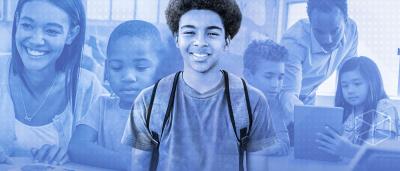Dolma Lhamo grew up in a nomadic community in Tibet, where her job was to collect cow dung for fuel and look after her little brother and cousin. Her schooling was minimal, due to limited curriculum and frequent relocation.
In 2006, Dolma moved to the United States with her family and settled in Queens, N.Y. She enjoyed school and thrived in her classes. Entering 12th grade, she had a 3.8 gradepoint average. But one question still puzzled Dolma and her parents—What should they do about college?
“I didn’t have any knowledge of college … and my parents didn’t have any knowledge,” Dolma recalls.
The college application process is hard enough for any student. But for first-generation immigrant students, especially those who are first-in-family college hopefuls, the application process involves a daunting set of challenges. As more schools take creative, proactive steps to help immigrant students attain their college goals and the political environment shifts in favor of supporting immigrant students, solutions are surfacing—and high school educators have a key role to play.
The first step is demystifying the process, says Michelle Knight, an associate professor at Teachers College, Columbia University and co-author of the book College-Ready: Preparing Black and Latina/o Youth for Higher Education. The application process in the United States is unfamiliar to many first-generation immigrant families. This inexperience makes it more difficult to map out a college-ready resume, fill out a college application or pursue much-needed financial aid.
“You don’t have access to social networks of people,” says Tamara Lucas, associate dean of Montclair State University’s College of Education and Human Services. “If you don’t have that, you’re sort of left out of the whole system. There’s not a way to get in the door, and you don’t know the steps to take.”
Educators can help immigrant families through the college application process in a number of ways. Pulling in outside organizations is a simple solution. San Diego-based Advancement Via Individual Determination (AVID), for instance, provides support structures in about 900 school districts across the country, helping middle school and high school students become more successful and navigate the college application process. Many other organizations do the same on national, regional and local levels.
Each year, approximately 65,000 undocumented students graduate from high school.
—Immigration Policy Center
Some schools set up their own college-readiness programs. The International High School (IHS) at LaGuardia Community College in Queens—from which Dolma graduated—is located on the college campus, and its students take community college courses as part of their schedules. Priority is given to applicants who have lived in the United States for less than four years and whose English proficiency is limited. More than half of all IHS students complete an optional fifth year of study in which they take only college courses and may earn an associate degree. On top of that, the school has a large number of counselors and student teachers, so each student receives one-on-one assistance with the college application process.
“Parents who are working 16 hours a day and don’t read English, they can’t sit with their kids and work with their application in a way that my parents could do,” says John Starkey, the school’s principal.
In addition to full-scale programs, schools can take other, smaller steps to help immigrant families with the college search. Counselors can work with students to discover which colleges are most welcoming to immigrant students. Peer groups, formed either within a single school or across several schools, allow parents and students to learn from one another about the college application process, which makes the task less daunting. And finally, teachers can take an active role in discussing college with students—a great tactic for schools with a shortage of counselors.
All immigrant college applicants must overcome the hurdles of an unfamiliar process, but some immigrant students face an additional challenge—lack of documentation. For students who are undocumented, college may seem an unattainable goal. But some colleges are now going out of their way to welcome undocumented students.
By finding these colleges and building relationships with them, high schools clear the path to college for their undocumented students. Lindblom Math and Science Academy in Chicago has done just this.
“We’ve built relationships with those colleges and universities that are good about giving money to undocumented students,” says Alan Mather, principal at Lindblom. “We’ve helped those students to see what those possibilities are—to see that there’s hope.”
In college-planning discussions, cultural values often arise as another key issue. Some immigrant parents may want their children to pursue a specific career path; others may not value a broad liberal arts education. Many want their children to remain close to home while attending college. These are big topics that require serious and respectful conversations.
Knight encourages schools to refrain from assuming that a decision to attend college close to home is the wrong one. “A college an hour and a half away could be the state flagship college,” she says. “We have to understand what judgments we’re placing on that cultural value.”
Nationally, in 2007-08, about 23 percent of all undergraduates were immigrants or second generation Americans.
—U.S. Department of Education
Even after the coveted acceptance letter has been received, immigrant students face yet another challenge: navigating another new environment. It’s important that educators give these students the tools to seek support once they’ve arrived at college.
“What we’re really trying to do is build self-advocacy,” IHS’s Starkey says. “How do you find out when the professor’s [office] hours are? How do you advocate for yourself when you go and see the professor? How do you set up groups of students with similar challenges to study together?”
As Dolma prepares to begin college at the State University of New York at Potsdam this fall, she’s had the chance to develop her self-advocacy skills by taking college-level language courses and by attending a student conference in South Carolina. Now, as she begins this next phase of her journey, Dolma advises fellow immigrant students to study hard while also reaching out for assistance.
“Keeping up the grades is really important,” she says. “If you don’t get any help, then it will be difficult to apply for college. You don’t have the knowledge of what college looks like, so it’s really important to get help from everyone.”
Never Give Up
In June 2003, Sabina Kozak graduated from high school at the top of her class. But she lacked documentation, a fact she didn’t feel safe sharing with everyone. So when friends asked about her college plans, she told them she was taking some time off.
“It’s just frustrating and annoying because everyone asks you,” Sabina recalls. “You can’t really tell the truth because if you tell the wrong person, there could be consequences for that. I was pretty depressed and down about it.”
Sabina’s story is not uncommon. She is one of many stellar students who have found their college choices limited by documentation status.
Finally, after 18 months, she was informed that an admissions officer at a university in Boston would overlook the citizenship box on her application. She applied to the school and was accepted. Sabina couldn’t apply for any scholarships due to her status, but she dove into her studies. Four years later, she graduated with a 3.79 GPA.
Sabina is now an instructor for the Thompson Island Outward Bound Education Center in Boston Harbor. She received her green card just a few months ago and is thinking about a career in education.
Her advice to students who are undocumented is simple: Never give up.
“You’ve got to stay hopeful and try to do as much as you can,” Sabina says. “You can still be making positive decisions. You can try to get unpaid internships, anything you can volunteer for, anything you can do.”

